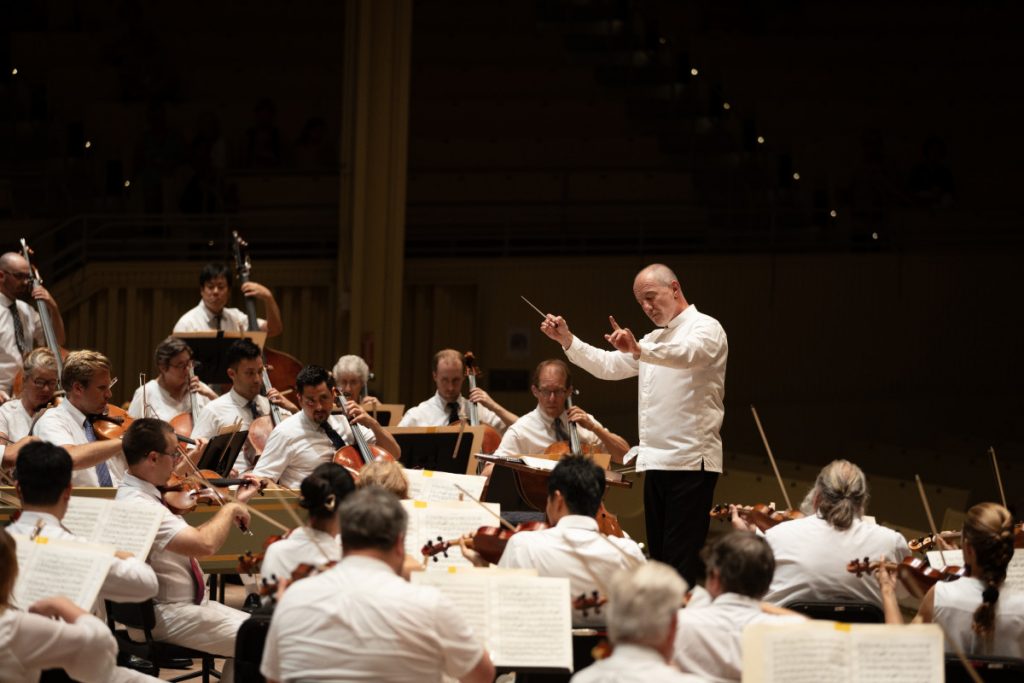
Gabriel Weber
Staff Writer
Romantic or twisted? The audience decides whether Hector Berlioz’s opium-fueled, lovesick visions are a result of all-consuming attraction or darker compulsions.
At 8:15 p.m. tonight in the Amphitheater, the Chautauqua Symphony Orchestra takes the stage with Music Director and Principal Symphonic Conductor Rossen Milanov leading them in Hector Berlioz’s “Symphonie fantastique,” Op. 14.
A cornerstone of the Romantic period, “Symphonie fantastique” is essentially an autobiography of Berlioz’s obsession with actress Harriet Smithson. When he went to see a production of Shakespeare’s Hamlet in Paris in 1827, in which Smithson played Ophelia, Berlioz later wrote:
“The impression made on my heart and mind by her extraordinary talent, nay, her dramatic genius, was equaled only by the havoc wrought in me by the poet she so nobly interpreted. That is all I can say.”
Berlioz had a history of uncontainable passion; when he fell in love with Marie-Félicité-Denise Moke and she broke off the engagement in favor of someone else, Berlioz actually planned to kill the pair, until he changed his mind — after buying the poisons and pistols. However, when Smithson found out “Symphonie fantastique” and its sequel “Lélio, ou Le retour à la vie” were inspired by her, the two became lovers, and after Berlioz swallowed a lethal dose of opium, Smithson agreed to marriage in a panic. Berlioz then produced the antidote.
“Symphonie fantastique” is programmatic, meaning that it tells a story, detailing a sensitive and imaginative young man — Berlioz — who poisons himself with opium then plunges into a strange slumber. Innovatively, Berlioz composed for instruments not typically used during that time and employed unusual orchestration, with certain instruments moving off stage to give the impression that the action is occurring on two different planes.
“It’s one of those works that I think one could benefit from hearing live, just because of how three-dimensional it is in the way it’s orchestrated,” Milanov said. “The sounds come from all over the place, but they’re very specific, so there’s a lot of instrumental drama in the way it unfolds. I think it benefits us from actually being able to observe that visually, in addition to being able to hear it aurally.”
The first three movements — “Reveries, Passion,” “A Ball” and “Scene in the Country” — are dreamy, said trombonist Eric Lindblom. “Reveries, Passion” introduces an idée fixe, a recurring theme that evokes longing, and depicts the suffering and joys of love.
In “A Ball,” Berlioz meets his loved one on the dance floor in the middle of a dazzling party. “Scene in the Country” is restful, until his love appears again and exacerbates his loneliness, featuring an oboe duet.
Tubaist Cristina Cutts Dougherty and Lindblom come in for the last two movements.
“The joke in the business is that we’re highest paid per note, because we don’t really get very many notes.
We’re used to resting and counting rests for a long time, and that’s just something that I get better and better at over time,” Cutts Dougherty said. “Especially with ‘Fantastique,’ I’ve played it really quite a few times, so I’ve gotten used to how it feels to listen and enjoy the beautiful music that my colleagues are making. Then it feels relatively easy to come in after that because it sounds so great.”
For the fourth movement, “March to the Scaffold,” Berlioz dreams that he has killed his beloved and is condemned to death.
“There’s a guillotine effect in that movement, and it’s very wild,” Lindblom said. “Playing the crowd noise, the parts are, register-wise, very extreme. The first one plays up to a high E flat, which is a very high note, and I have a lot of low B flat, so there’s a giant register. Playing together (is challenging) because there’s a lot of difficult rhythms.”
The final movement, “Dream of a Witches’ Sabbath,” depicts Berlioz at his own funeral amidst monsters of all kinds.
“It’s a totally crazy movement with very virtuosic woodwinds and strings,” Lindblom said. “Everybody’s pressed to the best ability to go through it. It’s very exciting; you can just see the witches dancing around the cauldron, and then the ‘Dies Irae’ comes into it, too.”
Since the composition was written for two tubas, Seth Rawleigh will be visiting Chautauqua from Buffalo Philharmonic Orchestra.
Originally written for an ophicleide — which is like a mix between bassoon and saxophone — the tuba part is extremely technically challenging, as it is higher than many “normal” tuba parts with many fast runs. Usually, Cutts Dougherty plays on a C tuba, but for this concert, she and Rawleigh will be playing on F tubas, which offer a higher range.
“It’s super-fun to play, to be totally honest; we get to do much more acrobatic things than we’re used to on the tuba with lots of big octave jumps and very fast articulations,” Cutts Dougherty said. “There’s also a big moment in the fifth movement when the whole orchestra stops playing, and it will just be the two tubas with some chimes going and we played the ‘Dies Irae’ theme, which is the ‘Death’ theme — it’s super intense — and it’s just the two of us. So it’s one of those rare tuba feature moments.”
Cutts Dougherty won her audition in 2024 and began her first official season with the CSO this year. Her interest began as she wanted to play a “boy instrument,” and tuba is incredibly skewed toward men. Meanwhile, Lindblom is an alum of the Music School Festival Orchestra and enjoys his full-circle return to Chautauqua, where the programming always keeps him on his toes.
“We go through probably as much repertoire in those eight to nine weeks as we would do maybe a whole season. To play a lot of the great works is very intensive, yet stimulating,” he said. “It’s a fun challenge. One important part of it is that you’re colleagues for two months, and then you don’t see each other for 10 months. … Then summer’s over, and then you miss the people and come back again. It’s kind of like visiting family.”




